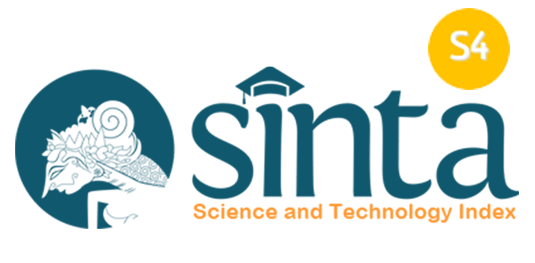Pola Komunikasi Orang Tua dalam Pengelolaan Siswa Berkebutuhan Khusus di Sekolah Luar Biasa
Abstract
Penelitian ini memiliki tujuan untuk mendeskripsikan strategi sekolah dalam mengkomunikasikan pengelolaan siswa berkebutuhan khusus. Metode yang digunakan adalah dengan metode kualitatif, dengan rencana penelitian studi kasus. Tempat penelitian ini di SLB Negeri Cendono Kudus. Teknik pengumpulan data dalam penelitian ini adalah menggunakan metode wawancara secara mendalam, observasi dan dokumentasi. Teknik analisis data yang digunakan adalah reduksi data, display data, dan penarikan kesimpulan. Hasil penelitian ini menunjukkan bahwa strategi sekolah dalam mengkomunikasikan pengelolaan siswa berkebutuhan khusus adalah melalui kelas orang tua berkomunikasi dengan guru bayangan, dan wali kelas berkomunikasi langsung dengan siswa orang tua. Strategi menggunakan pemanfaatan media elektronik seperti media sosial, buku penghubung serta pertemuan langsung dengan orang tua siswa, pemberdayaan guru bayangan dan perantara antara sekolah dengan orang tua, dan penggunaan beberapa media sebagai penghubung orang tua dengan sekolah.
References
Baumann, C., & Krskova, H. (2016). School discipline, school uniforms and academic performance. International Journal of Educational Management.
Bedell, G., Coster, W., Law, M., Liljenquist, K., Kao, Y.-C., Teplicky, R., Anaby, D., & Khetani, M. A. (2013). Community participation, supports, and barriers of school-age children with and without disabilities. Archives of Physical Medicine and Rehabilitation, 94(2), 315–323.
Dalbudak, I., Gürkan, A. C., Yigit, S. M., Kargun, M., Hazar, G., & Dorak, F. (2016). Investigating Visually Disabled Students’ Attitudes about Physical Education and Sport. International Journal of Environmental and Science Education, 11(16), 9437–9447.
Day, T., & Prunty, A. (2015). Responding to the challenges of inclusion in Irish schools. European Journal of Special Needs Education, 30(2), 237–252.
Falkmer, M., Anderson, K., Joosten, A., & Falkmer, T. (2015). Parents’ perspectives on inclusive schools for children with autism spectrum conditions. International Journal of Disability, Development and Education, 62(1), 1–23.
HEWARD, W. (2005). Exceptional Children: An Introduction to Special Education. Séptima Edición. Nueva Jersey. Prentice Hall. rajeda, A.(2005). Estudio psicométrico del Test de matrices ….
Kowalski, T. J. (2011). Public relations in schools.
Miles, S., & Singal, N. (2010). The Education for All and inclusive education debate: conflict, contradiction or opportunity? International Journal of Inclusive Education, 14(1), 1–15.
Preston, J. (2011). Influencing community involvement in school: A school community council. McGill Journal of Education/Revue Des Sciences de l’éducation de McGill, 46(2), 197–212.
Qvortrup, A., & Qvortrup, L. (2018). Inclusion: Dimensions of inclusion in education. International Journal of Inclusive Education, 22(7), 803–817.
Saiful, S., & Asfarawenti, S. (n.d.). INTELLECTUAL CAPITAL AND BANKS PERFORMANCE: THE EMPIRICAL EVIDENCES FROM INDONESIAN ISLAMIC AND CONVENTIONAL BANKS. Research Journal of Business and Management, 6(3), 149–157.
Slavit, D., Nelson, T. H., & Lesseig, K. (2016). The teachers’ role in developing, opening, and nurturing an inclusive STEM-focused school. International Journal of STEM Education, 3(1), 7.
Sumarsono, R B, & Imron, A. (2017). Manajemen Hubungan dan Partisipasi Masyarakat di Sekolah. Universitas Negeri Malang.
Sumarsono, Raden Bambang, Imron, A., Wiyono, B. B., & Arifin, I. (2016). Parents’ Participation in Improving the Quality of Elementary School in the City of Malang, East Java, Indonesia. International Education Studies, 9(10), 256–262.
Tjernberg, C., & Mattson, E. H. (2014). Inclusion in practice: a matter of school culture. European Journal of Special Needs Education, 29(2), 247–256.

This work is licensed under a Creative Commons Attribution-ShareAlike 4.0 International License.
LETTER OF ORIGINALITY AND COPYRIGHT TRANSFER AGREEMENT
As an author of Dawuh Guru: Jurnal Pendidikan Guru MI/SD of PGMI Department of Tarbiyah Faculty, Institut Pesantren Mathali’ul Falah and Perkumpulan Dosen PGMI Indonesia, I, who sign below:
Declare that:
- My paper is authentic; my own writing and it has not been published/proposed in any other journals or publications.
- My paper is not plagiarism but my original idea/research.
- My paper is not written by other help, except by the Board of Editors and Reviewers recommendation who have been chosen by this journal.
- In my paper, there are no other writings or opinions except those referred to in the bibliography and relevant to the rule of writing in this journal.
- I do the transfer copyright of this paper to Dawuh Guru: Jurnal Pendidikan Guru MI.
- I make this assignment surely. If there are distortions and untruths in this assignment, later, I will take responsibility as the current law.

This work is licensed under Creative Commons Attribution-ShareAlike 4.0 International License.








